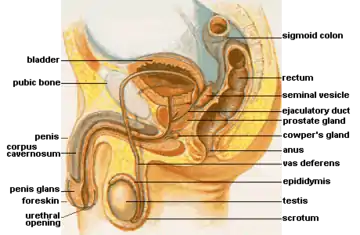Bulbourethral gland
The bulbourethral glands or Cowper's glands (named for English anatomist William Cowper) are two small exocrine glands in the reproductive system of many male mammals. They are homologous to Bartholin's glands in females. The bulbourethral glands are responsible for producing a pre-ejaculate fluid called Cowper's fluid (known colloquially as pre-cum), which is secreted during sexual arousal, neutralizing the acidity of the urethra in preparation for the passage of sperm cells.[1]
| Bulbourethral gland | |
|---|---|
 Male anatomy | |
 Micrograph of bulbourethral gland. H&E stain. | |
| Details | |
| Precursor | Urogenital sinus |
| Artery | Artery of the urethral bulb |
| Identifiers | |
| Latin | glandulae bulbourethrales |
| MeSH | D002030 |
| TA98 | A09.3.09.001 |
| TA2 | 3659 |
| Anatomical terminology | |
Most species of placental mammals have bulbourethral glands, but they are absent in whales, dolphins, and porpoises. They are the only accessory reproductive glands in male monotremes. Placental mammals usually have 1 pair of bulbourethral glands, while male marsupials have 1–3 pairs.[2] Of all domesticated animals, they are absent only in dogs.[3]
Location
Bulbourethral glands are located posterior and lateral to the membranous portion of the urethra at the base of the penis, between the two layers of the fascia of the urogenital diaphragm, in the deep perineal pouch. They are enclosed by transverse fibers of the sphincter urethrae membranaceae muscle.
Structure

The bulbourethral glands are compound tubulo-alveolar glands, each approximately the size of a pea in humans. In chimpanzees, they are not visible during dissection, but can be found on microscopic examination.[4] In boars, they are up to 18 cm long and 5 cm in diameter.[3] They are composed of several lobules held together by a fibrous covering. Each lobule consists of a number of acini, lined by columnar epithelial cells, opening into a duct that joins with the ducts of other lobules to form a single excretory duct. This duct is approximately 2.5 cm long and opens into the bulbar urethra at the base of the penis. The glands gradually diminish in size with advancing age.[5]
Function
The bulbourethral gland contributes up to 4 ml of fluid during sexual arousal.[6] The secretion is a clear fluid rich in mucoproteins that help to lubricate the distal urethra and neutralize any acidic urine residue that remains in the urethra.
According to one preliminary study, the bulbourethral gland fluid might not contain any sperm,[7] whereas another study showed some men did leak sperm in potentially significant quantities (in a range from low counts up to 50 million sperm per ml) into the pre-ejaculatory fluid,[6] potentially leading to conception from the introduction of pre-ejaculate. However, the sperm source is a residual or pre-ejaculatory leak from the testicles into the vas deferens,[6] rather than from the bulbourethral gland itself.[7]
Gallery
 Structure of the penis
Structure of the penis Male pelvic organs seen from right side
Male pelvic organs seen from right side Vertical section of bladder, penis, and urethra
Vertical section of bladder, penis, and urethra Bulbourethral gland labeled at center left
Bulbourethral gland labeled at center left
See also
References
- "What is pre-ejaculatory fluid (also known as pre-cum), and can it cause pregnancy?". International Planned Parenthood Federation. 13 February 2019. Retrieved 21 July 2019.
- Dixson, Alan F. (2021-06-03). Mammalian Sexuality: The Act of Mating and the Evolution of Reproduction. Cambridge University Press. ISBN 978-1-108-69949-5.
- Mark McEntee (December 2, 2012). Reproductive Pathology of Domestic Mammals. Elsevier Science. p. 333. ISBN 978-0-323-13804-8. Retrieved August 20, 2013.
- Jeffrey H. Schwartz (1988). Orang-utan Biology. Oxford University Press. p. 92. ISBN 978-0-19-504371-6. Retrieved August 20, 2013.
- Gray's Anatomy, 38th ed., p 1861.
- Killick, S. R; Leary, C; Trussell, J; Guthrie, K. A (2010). "Sperm content of pre-ejaculatory fluid". Human Fertility. 14 (1): 48–52. doi:10.3109/14647273.2010.520798. PMC 3564677. PMID 21155689.
- Zukerman, Z; Weiss, D. B; Orvieto, R (2003). "Short Communication: Does Preejaculatory Penile Secretion Originating from Cowper's Gland Contain Sperm?". Journal of Assisted Reproduction and Genetics. 20 (4): 157–159. doi:10.1023/A:1022933320700. PMC 3455634. PMID 12762415.
